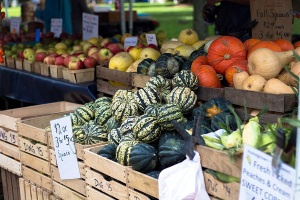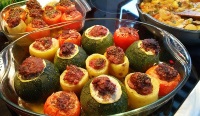Many of the Jewish holidays are defined by their culinary traditions. Passover is characterized by its strict dietary laws and myriad matzahs, Rosh Hashanah is renowned for its apples and honey, and summery Shavuot is a celebration of dairy delights.
From a culinary perspective, Sukkot is an oddity. There are no food-related laws related to this week-long fall holiday, and – unusually for Jewish festivals – it hasn’t evolved any food customs that are so religiously adhered to that they might as well be law (latkes and hamentaschen, anyone?).
So what do Jews eat on Sukkot?
It’s become customary to eat stuffed foods on Sukkot.
Seem a little odd? There are two things to take into account:
- Sukkot is the Jewish calendar’s fall-time harvest festival
- Symbolism is super important in Jewish food
Just like Rosh Hashanah’s apples and honey are symbols for a sweet year ahead, Sukkot’s stuffed foods were a luxury for our poor, rural ancestors (especially farm-laboring eastern Europeans). They symbolize the bountiful, plentiful harvest we hope that the fall will bring.
Traditional stuffed foods include kreplach (meat-filled dumplings served in soup) and holishkes (cabbage leaves filled with flavorful ground meat and baked in a sweet sauce) for Ashkenazi Jews, and rice-stuffed vine leaves and kubbeh (meat-filled semolina dumplings eaten with soup) for those of Sephardic origin.
 Another beautiful Sukkot tradition focuses on the idea of a plentiful harvest. We use seasonal fall foods to create delectable, unforgettable meals in tribute to the season’s bounty, including butternut squash and other winter squashes, root vegetables, bramble-grown berries, apples, and pears. This is a wonderful opportunity to shop for homegrown ingredients. You’ll find the best quality fresh produce at your local farmer’s market or greengrocers – with the added bonus of supporting local business and small suppliers!
Another beautiful Sukkot tradition focuses on the idea of a plentiful harvest. We use seasonal fall foods to create delectable, unforgettable meals in tribute to the season’s bounty, including butternut squash and other winter squashes, root vegetables, bramble-grown berries, apples, and pears. This is a wonderful opportunity to shop for homegrown ingredients. You’ll find the best quality fresh produce at your local farmer’s market or greengrocers – with the added bonus of supporting local business and small suppliers!
Another important point about Sukkot food: Rain permitting, we eat as many meals as possible outside in the sukkah. Unless your sukkah is integrated into your dining room or just a couple of steps out of your back door, bear in mind that you’ll need to carry everything out with you. Sukkot is not the time for individually plated dishes with specific serving temperatures, but it’s perfect for warming, one-pot comfort food like stews, pies, and pot-roasts.
If you’re looking for original menu suggestions, keep reading…
Butternut Squash Soup
 Keep it classic: sweat a chopped onion and a couple of garlic cloves; blend into roasted, boiled or pureed squash; thin down with vegetable or chicken stock and season to taste (a little ground cinnamon makes this taste like fall in a bowl!). For something more exciting, fry your onions with a spoonful of red or yellow curry paste and substitute some of your liquid for coconut milk. Serve with a squeeze of lime. These soups will also work wonderfully with pumpkin or sweet potato.
Keep it classic: sweat a chopped onion and a couple of garlic cloves; blend into roasted, boiled or pureed squash; thin down with vegetable or chicken stock and season to taste (a little ground cinnamon makes this taste like fall in a bowl!). For something more exciting, fry your onions with a spoonful of red or yellow curry paste and substitute some of your liquid for coconut milk. Serve with a squeeze of lime. These soups will also work wonderfully with pumpkin or sweet potato.
Stuffed Vegetables
 Sounds super standard, right? Wrong! Perfect as meat, vegetarian or vegan mains, you can literally stuff any vegetable with any filling to create a sumptuous centerpiece your guests will love! The classic Ashkenazi main includes ground meat (and rice, sometimes) folded into cabbage leaves and braised in a rich tomato sauce. Dairy favorites include finely sliced leeks and mushrooms in a creamy, cheesy sauce used to fill baby butternut squashes or round zucchinis. You could also stuff portobello mushrooms, bell peppers, zucchini boats or giant tomatoes with a mixture of rice or orzo, fried onions, and lentils, and bake the filled veggies in a rich tomato sauce. Just figure out your favorite veg, grain and protein combinations and get creative!
Sounds super standard, right? Wrong! Perfect as meat, vegetarian or vegan mains, you can literally stuff any vegetable with any filling to create a sumptuous centerpiece your guests will love! The classic Ashkenazi main includes ground meat (and rice, sometimes) folded into cabbage leaves and braised in a rich tomato sauce. Dairy favorites include finely sliced leeks and mushrooms in a creamy, cheesy sauce used to fill baby butternut squashes or round zucchinis. You could also stuff portobello mushrooms, bell peppers, zucchini boats or giant tomatoes with a mixture of rice or orzo, fried onions, and lentils, and bake the filled veggies in a rich tomato sauce. Just figure out your favorite veg, grain and protein combinations and get creative!
Pro Tip: cook any grain or small pasta shape you’re using as a filling in stock instead of water. This will give the finished dish an impressive depth of flavor.
Perfect Pies
 Pies look super impressive and are a delicious way to wow your family and friends. But the way I see it, a pie is just a stew with a golden, flaky pastry lid. It’s a great way to use up cheap cuts of meat or bruised vegetables: a slow braise and a loving hand will give a gorgeous result, every time. Try a classic chicken pot pie, a deeply flavored beef pie cooked in wine with plenty of vegetables, or my personal favorite – a vegetarian mushroom and Guinness pie! Serve with a pile of creamy mashed potatoes, something green, and a glass of your favorite red wine.
Pies look super impressive and are a delicious way to wow your family and friends. But the way I see it, a pie is just a stew with a golden, flaky pastry lid. It’s a great way to use up cheap cuts of meat or bruised vegetables: a slow braise and a loving hand will give a gorgeous result, every time. Try a classic chicken pot pie, a deeply flavored beef pie cooked in wine with plenty of vegetables, or my personal favorite – a vegetarian mushroom and Guinness pie! Serve with a pile of creamy mashed potatoes, something green, and a glass of your favorite red wine.
Pastry not your thing? Try making savory scones or dumplings instead for a unique topping.
We’d love to know what you’re cooking up for the holiday. Leave us a comment below!











